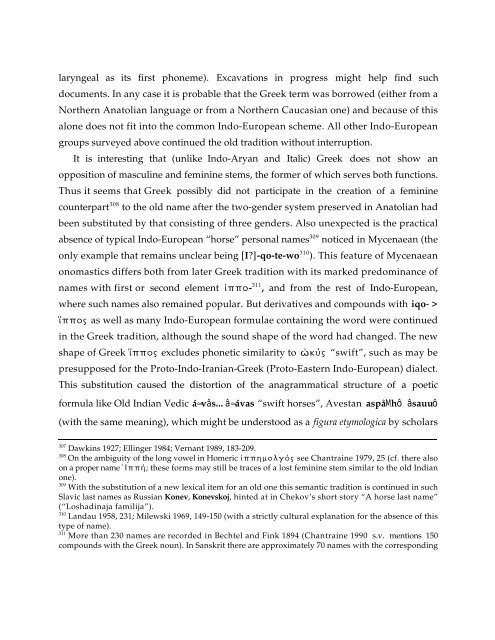Comparative Notes on Hurro-Urartian, Northern Caucasian
Comparative Notes on Hurro-Urartian, Northern Caucasian
Comparative Notes on Hurro-Urartian, Northern Caucasian
You also want an ePaper? Increase the reach of your titles
YUMPU automatically turns print PDFs into web optimized ePapers that Google loves.
laryngeal as its first ph<strong>on</strong>eme). Excavati<strong>on</strong>s in progress might help find such<br />
documents. In any case it is probable that the Greek term was borrowed (either from a<br />
<strong>Northern</strong> Anatolian language or from a <strong>Northern</strong> <strong>Caucasian</strong> <strong>on</strong>e) and because of this<br />
al<strong>on</strong>e does not fit into the comm<strong>on</strong> Indo-European scheme. All other Indo-European<br />
groups surveyed above c<strong>on</strong>tinued the old traditi<strong>on</strong> without interrupti<strong>on</strong>.<br />
It is interesting that (unlike Indo-Aryan and Italic) Greek does not show an<br />
oppositi<strong>on</strong> of masculine and feminine stems, the former of which serves both functi<strong>on</strong>s.<br />
Thus it seems that Greek possibly did not participate in the creati<strong>on</strong> of a feminine<br />
counterpart 308 to the old name after the two-gender system preserved in Anatolian had<br />
been substituted by that c<strong>on</strong>sisting of three genders. Also unexpected is the practical<br />
absence of typical Indo-European “horse” pers<strong>on</strong>al names 309 noticed in Mycenaean (the<br />
<strong>on</strong>ly example that remains unclear being [I?]-qo-te-wo 310 ). This feature of Mycenaean<br />
<strong>on</strong>omastics differs both from later Greek traditi<strong>on</strong> with its marked predominance of<br />
names with first or sec<strong>on</strong>d element flppo- 311 , and from the rest of Indo-European,<br />
where such names also remained popular. But derivatives and compounds with iqo- ><br />
·ppow as well as many Indo-European formulae c<strong>on</strong>taining the word were c<strong>on</strong>tinued<br />
in the Greek traditi<strong>on</strong>, although the sound shape of the word had changed. The new<br />
shape of Greek ·ppow excludes ph<strong>on</strong>etic similarity to »kÊw “swift”, such as may be<br />
presupposed for the Proto-Indo-Iranian-Greek (Proto-Eastern Indo-European) dialect.<br />
This substituti<strong>on</strong> caused the distorti<strong>on</strong> of the anagrammatical structure of a poetic<br />
formula like Old Indian Vedic á≈vâs... â≈ávas “swift horses”, Avestan aspåMhô âsauuô<br />
(with the same meaning), which might be understood as a figura etymologica by scholars<br />
307 Dawkins 1927; Ellinger 1984; Vernant 1989, 183-209.<br />
308 On the ambiguity of the l<strong>on</strong>g vowel in Homeric flpphmolgÒw see Chantraine 1979, 25 (cf. there also<br />
<strong>on</strong> a proper name ÑIppÆ; these forms may still be traces of a lost feminine stem similar to the old Indian<br />
<strong>on</strong>e).<br />
309 With the substituti<strong>on</strong> of a new lexical item for an old <strong>on</strong>e this semantic traditi<strong>on</strong> is c<strong>on</strong>tinued in such<br />
Slavic last names as Russian K<strong>on</strong>ev, K<strong>on</strong>evskoj, hinted at in Chekov’s short story “A horse last name”<br />
(“Loshadinaja familija”).<br />
310 Landau 1958, 231; Milewski 1969, 149-150 (with a strictly cultural explanati<strong>on</strong> for the absence of this<br />
type of name).<br />
311 More than 230 names are recorded in Bechtel and Fink 1894 (Chantraine 1990 s.v. menti<strong>on</strong>s 150<br />
compounds with the Greek noun). In Sanskrit there are approximately 70 names with the corresp<strong>on</strong>ding





